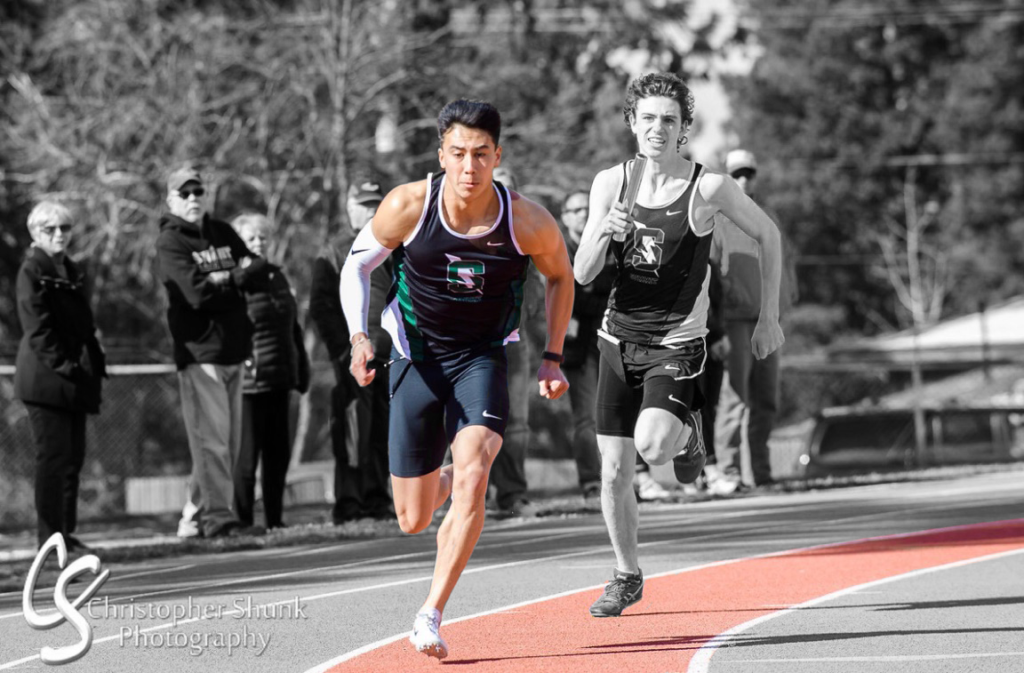By: Sean Wells
In our OC Sports Performance program we have worked with high school sprinters on and off for multiple years before having one to commit to allowing us to train him throughout his senior season. Brayden Durfee’s results and his training are detailed below. Brayden attends Boise State University and is on their track team – congratulations Brayden!
The Conjugate System is the system.
The Conjugate System was learned from reading multiple books on the system(listed at the end of the article). Also from visiting Westside Barbell in Columbus, Ohio and a week-long visit to The Sweatt Shopp in Blue Ash, Ohio. Both of these gyms work with athletes in all sports. Including sprinters and other explosive athletes(football, track, volleyball, baseball among others). Thank you to both of these gyms for the help along the way in learning this training system.
Training is organized to have two “Max Effort” days each week. Along with two “Dynamic Effort” days:
Brayden completed these “Max Effort Days” on Monday and Friday. Monday was max effort lower body. Friday was max effort upper body. The work Brayden did on Tuesday and Thursday was for the Dynamic effort. Wednesday was a restoration/recovery day. Furthermore Wednesday was opportunity to work on sport specific time areas in which a sprinter competes. For example: a top 100m time in high school is 10-11 seconds so we used efforts inside of that time frame to develop sport specific training.
On Monday: which is max effort lower body day.
The goal of Monday is to move the heaviest possible weight on a single repetition. We utilized one of the following movements: squat to a box, a sumo deadlift, a rack pull, a partial squat to pins in the power rack or some other variations. OC Sports Performance uses the max effort method because it is the greatest strength method ever invented. When an athlete performs a sprint they are performing a max effort sprint! The forces generated while sprinting are over a 1000# for top level sprinters, so training using heavy weights produces a stronger/faster athlete and is sport specific. The box squats and/or deadlifts were completed with accommodating resistance implements(bands, chains or a combination of both).
After the max effort lift:
Brayden would do assistance exercises specifically targeting weaknesses in sprints – hamstrings, calves, glutes and low back. Lots of reverse hyper, inverse leg curls, standing hamstring curls, lying hamstring curls, and back extensions were used among others. Additionally, either before or after the max effort work Brayden would complete 40 box jumps at various heights and weights.
Tuesday we perform dynamic effort upper body work to develop upper body speed.
A typical day would have Brayden doing 9 sets of 3 reps using 50% of the athletes one rep bench press and using 25% accommodating resistance. The accommodating resistance was applied using bands or chains or a combination of both. The work was done as fast as possible(:20-:30 rest periods), rotating grips between each set from close, medium and wide hand placements. After, Brayden would do a multiple rep max with db’s maybe 10 rep dumbbell bench press, or a 20 rep dumbbell floor press. After these were done Brayden’s work would target upper body weak areas, such as the upper back, mid back, and triceps. The volume of total work was high and the pace of the training was kept quick.
On Wednesday we worked restoration type activities:
Dragging a weighted sled, hooked from a belt around the athletes waist. Brayden also did walks on the athletic training platform. Also on Wednesday, sports specific exercises are completed to duplicate the times associated with the sprinting events – such as running on a self powered treadmill(TRUFORM) for 12 seconds/25 seconds/55 seconds intervals. These times were slightly longer than the times the athlete had on a 100m, 200m and 400m sprints. Also, Brayden did lots of timed work on the reverse hyper, or inverse curl, going for those time domains that would be needed during the sprints.
Thursday, we used dynamic effort lower body work for Speed.
A typical lower body day, would have Brayden squat to a box for 5 sets and 5 reps, with a minute or less of rest between sets. The bar would either have band tension, chains, or combination of both hung from it and we do did our squats at 75-80-85% of our one rep max(combination of resistance). As soon as the squats were done Brayden would go and pull sumo deadlift with band tension/chain/both for 8 sets and 3 reps. The rest for the deadlifts was between :30 and 1:00. The deadlifts were almost always done with a sumo stance(2/3rds of the time) and used 80% of the 1 rep max sumo deadlift.
After the deadlifts:
Brayden would do 40 weighted box jumps again varying stance, weights, heights. Finally, Brayden would finish the day with lots of standing abs, inverse curls, reverse hypers, standing hamstring curls and walks on the ATP.
Friday, was our max effort upper body day.
Brayden would have max out a bench press, bench press variation, standing press, or a dumbbell variation. About half of the time Brayden would use accommodating resistance on the barbell work and full range of motion. The other half of the time Brayden would either do partials to a pin or board. After max effort upper body work was completed, Brayden would do lots of upper back and tricep work. The work was to put “muscle” where he needed it. If we look at high level college, and professional track athletes most of them are “jacked” and they are our “model” to try replicate.
Saturday’s:
When there were no races, Brayden drag more sled and do more work for the low back and hamstrings. On race days, Brayden still worked out! – utilizing different methods. This type was done in season and out of season and produced superior results than previously Brayden has experienced.
The Results Speak for themselves:
| Race | 2016 | 2017 |
| 100m | 11.11 | 10.6 |
| 200m | 22.46 | 21.36 |
| 400m | 49.15 | 49.22 |
| 400m(Split) | 51.34 | 48.14 |

Frequently asked questions:
Where are the power cleans?
We did 0 power cleans in Brayden’s daily/weekly training.
Why did you not program power cleans?
The reason we did not program power cleans in Brayden’s training is that between the jumps we did (at least 80 a week) and the dynamic effort sumo deadlifts, there was no reason to do the power cleans. When we look at the daily life of a high school kid they spend a ton of time in a seated position. A lot people who power clean, they end up catching in a compromised position. Plus, coaching a power clean takes time- the overwhelming issues with kids coming into the facility is that they aren’t strong and they don’t have a lot of time to train – we can teach a deadlift faster and get them lifting more weight with a deadlift faster – thus producing faster results with no injuries.
What running did you do?
There was no running programmed. (besides the self powered treadmill). Brayden dragged sled, either as a warm up or as a workout(Wednesday and Saturday) but no running him. Brayden has coaches to work on his running technique with him. The focus is always on what we know:- how to increase strength and in turn run faster. Running a kid day in and day out makes a kid tired, it doesn’t make them faster. Doing speed ladders is a demonstration of what they already have, not a builder of what they don’t have.
What did you suggest for warm ups on race day?
The suggestion was that Brayden cut his warm ups significantly down – he tried it and ran faster times! The suggestion was to cut his warm up by 1/3rd. Warm up activities included banded good mornings, banded hamstring curls, glute bridges banded and then a few starts out of blocks, over strides and then go run the race.
Why did you train on race day and before race day?
Training is modified before big races to ensure Brayden wasn’t sore. The day of big races we utilized isometrics to “excite his central nervous system” and the isometrics seemed to work as Brayden reported feeling “faster” and then ran faster.
Resources that shaped the Programming:
- Explosive Strength for Jumping, Louie Simmons
- Facts and Fallacies of Fitness, Mel Siff
- Science and Practice of Strength Training, Vladimir Zatsiorsky
- Special Strength Training, Manual for Coaches, Yuri Verkhoshansky
- Supertraining, Mel Siff
- Strength Training for Running, Louie Simmons
- Underground Secrets to Faster Running, Barry Ross

Book a Free Consult Today!
Thanks for checking out OC in Bend, Oregon. OC Sports Performance is Central Oregon’s premier, Personal Training, and Sports Performance gym in Bend, Oregon.
Other articles about speed training: 40 yard dash training, Speed – Metrics and Results Driven, 40 yard sprint help, How to Run faster.


